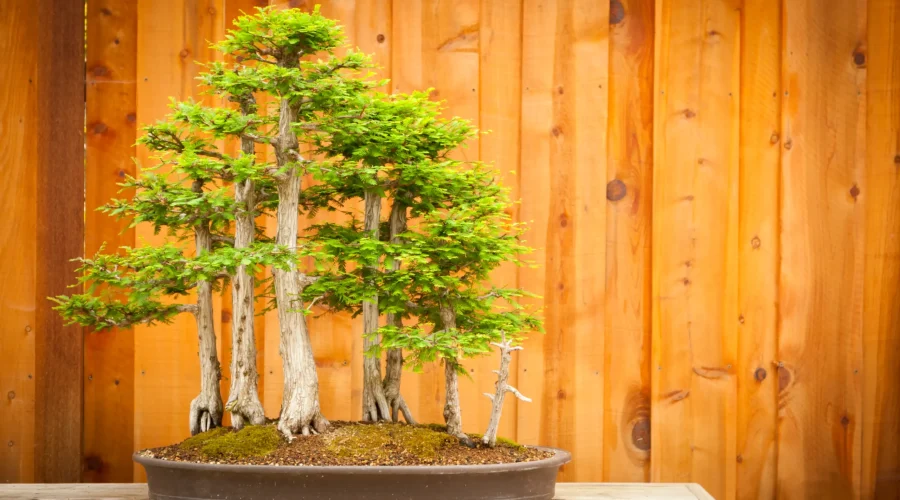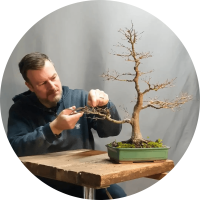How To Care for an Taxodium Distichum

The Taxodium distichum, commonly known as the Bald Cypress or Swamp Cypress, is a unique deciduous conifer native to the wetlands of the southeastern United States. It’s famous for its distinctive feathery foliage, rugged bark, and the ability to thrive in both flooded and dry environments.
As a bonsai, it brings a sense of ancient strength and quiet resilience, combining the grace of fine needles with the powerful presence of a thick, buttressed trunk.
Taxodium Distichum at a glance
In nature, the Bald Cypress grows along riverbanks and swamps, where its roots often rise above the waterline as “knees.” As a bonsai, it adapts remarkably well to container life, developing a straight, noble trunk and bright green leaves that turn a warm orange-brown in autumn before falling. This species is highly adaptable to various climates, provided it receives plenty of sunlight and moisture.
How often should I water my Taxodium Distichum
Watering a Taxodium distichum bonsai is all about maintaining steady moisture, this species thrives on consistent hydration. The soil should never dry out completely, especially during the growing season from spring to early autumn. Water thoroughly once the top layer feels slightly damp rather than dry, ensuring water flows freely from the drainage holes. In warm weather, this may mean watering once or even twice a day, particularly if the bonsai is kept in full sun or shallow pots.
Because the Bald Cypress naturally grows in swampy areas, it even tolerates standing water, you can safely place the pot in a shallow tray of water during the hottest months to help it stay evenly moist. In winter, when the tree becomes dormant and sheds its leaves, reduce watering slightly but keep the soil lightly moist at all times to protect the fine roots. Consistent moisture is the key to maintaining the Bald Cypress’s lush foliage and long-term vitality.
How much light does my Taxodium Distichum
Your Taxodium distichum bonsai thrives best in full sun, which encourages strong, upright growth and vibrant foliage colour. Ideally, it should receive at least six hours of direct sunlight per day throughout the growing season. Full sun exposure promotes dense branching, compact leaf structure, and the rich orange-brown autumn tones that make this species so striking.
While it enjoys high humidity, the Bald Cypress also needs good airflow, so avoid placing it in enclosed or shaded areas. In very hot climates, a bit of afternoon shade can prevent the fine foliage from drying out too quickly, but generally, more light equals better health.
During winter dormancy, when the tree has shed its leaves, it can remain outdoors in a bright, sheltered spot, sunlight helps maintain a stable temperature and supports a strong start in spring.

What's the best temperature for my Taxodium Distichum?
The Taxodium distichum, or Bald Cypress, thrives in a wide temperature range, reflecting its origins in the warm, humid wetlands of the southeastern United States. Its ideal growing temperature is between 15 °C and 30 °C (59 °F – 86 °F), though it can easily tolerate brief highs above 35 °C (95 °F) if the roots remain well-watered. During the growing season, consistent warmth and humidity encourage vigorous growth, strong roots, and lush green foliage.
As a deciduous conifer, the Bald Cypress requires a proper winter dormancy period. When temperatures drop below 10 °C (50 °F), the tree begins to shed its feathery leaves and enter rest mode. Mature specimens are very cold-hardy and can withstand temperatures down to –10 °C (14 °F) without issue, provided the soil doesn’t freeze solid. In regions with harsher winters, move the bonsai to a cold frame, unheated greenhouse, or sheltered balcony to protect the roots from prolonged frost while still allowing it to experience natural cold.
Fertilising your Taxodium Distichum
Because this species grows quickly, it benefits from regular feeding. Apply a balanced fertiliser every two weeks from early spring until mid-summer. Once growth slows down in late summer, switch to a low-nitrogen formula to harden the wood before dormancy. Organic fertiliser pellets or diluted liquid fertilisers both work well.
Avoid fertilising during the dormant period, as the tree’s metabolism is minimal and excess nutrients can harm the roots.
Do I need to prune my Taxodium Distichum?
Pruning a Bald Cypress bonsai requires attention and patience. During the growing season, trim back new shoots after they produce four to six leaves, leaving one or two pairs to maintain the structure. This encourages ramification and helps define the classic tiered look of the species.
Major structural pruning is best done in late winter, before buds open. The wood is flexible and responds well to wiring, but branches should be checked regularly since the bark can mark easily as it thickens. Defoliation is not recommended — instead, rely on careful trimming and seasonal pruning to refine the canopy.
When to repot an Taxodium Distichum?
Repot young Bald Cypress bonsai every two years, and mature ones every three to four years. The best time is early spring, just before bud swelling. Use a soil mix that retains moisture but still drains well, for example, a blend of akadama, pumice, and lava rock with a higher proportion of akadama or even some peat to help retain water.
When repotting, prune thicker roots moderately and keep plenty of fine feeder roots. After repotting, water thoroughly and keep the bonsai shaded for two weeks to allow root recovery.
Common Problems
The Bald Cypress is generally hardy and pest-resistant, but it can experience leaf browning if underwatered or exposed to strong, dry winds. Watch out for aphids and spider mites in summer; regular misting and good airflow help prevent infestations. Root rot is the main risk, but it only occurs in stagnant, compact soil, fresh, well-oxygenated mixtures prevent it.
With consistent care, your Taxodium distichum bonsai will reward you with a majestic silhouette, vivid seasonal colour, and the tranquil aura of a centuries-old tree thriving in miniature form.

Written by Luca Valagussa
Founder and bonsai master of Treevaset
Formerly in finance, Luca turned his lifelong passion for bonsai into his profession to make bonsai art simple, inspiring, and accessible to everyone.
